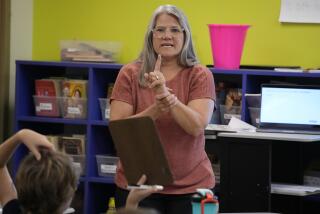Calculators in Math Class
- Share via
Your June 28 editorial on math education (“The ‘Why’ of Math”) certainly hit one nail on the head: This country is in serious need of math teachers with solid math training. It’s not enough to have teachers trained in process and barely competent in subject matter.
However, the study you cite that attempts to explain the success of Asian students in math exams misses one crucial factor that may well differentiate Asian students from American students: namely, work ethic. In my many years of teaching experience, I have found that, as a general rule, Asian students work harder. There is no royal road to success in mathematics.
Competent teachers certainly help, but hard work by students is equally important. Until our society places as much value on that sort of effort as do some Asian cultures, our success levels in mathematics will continue to lag.
Peter Kahn
Professor of Mathematics
Cornell University
Ithaca, N.Y.
*
As a 22-year veteran of math teaching, I believe that the “why” of math as well as math concepts are best communicated when students actively use technology in the classroom. I teach my students to be resourceful: to verify the work they’ve done and the concepts they’re learning by producing a quick graph, or a quick linear function, or by finding the sum of a sequence on a graphing calculator. Not only does this give a second approach to the concept, but it builds their confidence.
Unfortunately, every spring these same students are asked to temporarily forgo technology. For at least a few weeks my students practice such antiquated paper-and-pencil algorithms as long division, adding columns of numbers, carrying and borrowing and regrouping fractions.
Why? Because none of the California standardized tests for high school math allows even the simplest of calculators. So instead of concentrating on the “why” of math or on concepts at all, we have to practice archaic methods whose very risk of error alone make them ridiculous to all but the most eccentric and Luddite of adults.
I keep hoping the California testing bureaucracy will join the modern world and require at least scientific, or perhaps graphing, calculators on the CAT 6 (California Achievement Test) and on the high school exit exam.
The SAT test allows graphing calculators. So do the Advanced Placement Statistics and half of the AP Calculus tests.
After all, can students of the 21st century really claim math competency without demonstrating any calculator or computer skills?
Wes White
Whittier
*
Thank you for your excellent editorial regarding the importance of conceptual development in mathematics instruction. However, I would like to clarify the role of hands-on materials in this process.
The use of manipulatives is not intended merely to make students feel good or to give them toys to play with. To the contrary, concrete materials such as base-10 blocks, color tiles and pattern blocks are used to model abstract mathematical concepts and relationships. Respectively, these items might be used to extend an understanding of place value to decimals; to investigate the relationship between area and perimeter, when one is held constant; to identify the attributes of polygons. These challenging topics are all identified by the state standards for instruction in third and fourth grade.
When manipulatives are used under the supervision of an instructor who has the necessary knowledge, not only of the mathematical content but also pedagogy and classroom management, they are an effective tool for developing conceptual understanding.
Scientists and mathematicians create models of sophisticated ideas so that they can understand them better and communicate that understanding to the layman. Why would we deny these tools to our children as they grapple with mathematical content that few adults actually understand?
George Crowder
Math Coach
Plasencia Elementary School
LAUSD
*
Your editorial focuses on a chronic problem that approaches crisis proportions in the 21st century. Yes, “ ... one difference marked U.S. schools: Teachers here were less likely to teach the concepts behind the mechanics, or even explain how they reached a math solution.”
Why? The answer is in the editorial: “a third of U.S. math teachers lack a major or minor in the subject.... “ The sine qua non of all teaching is a thorough knowledge of the subject being taught. Teachers who lack even a minor in mathematics can hardly be expected to teach mathematics. The editorial is sound and should be required reading for all school board members everywhere.
Devon Showley
Cypress


